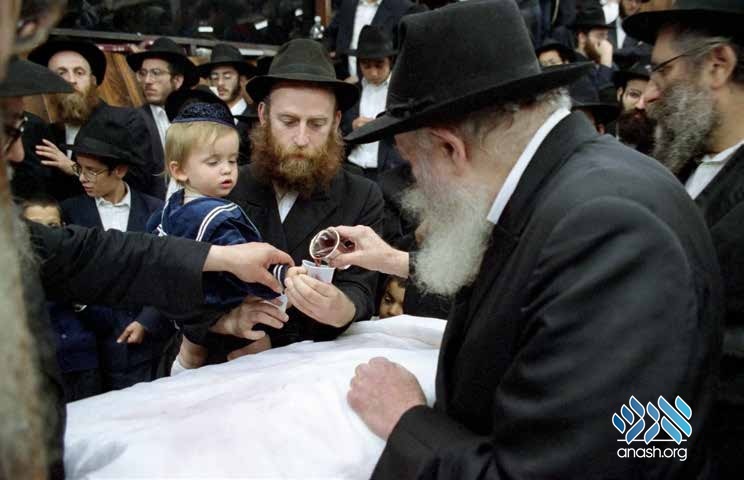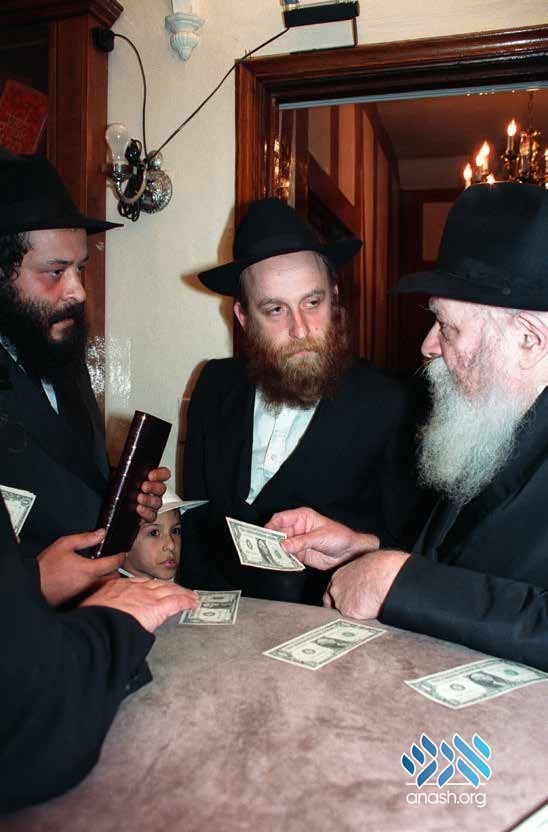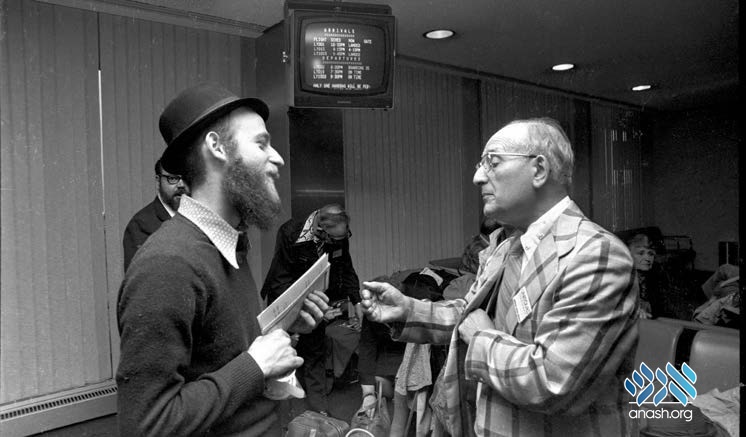כ׳ סיון ה׳תשע״ט | June 22, 2019
From Brunoy to New Haven, Constant Kiruvim
In their fourth issue, Hanochos magazine conducted an interview with Rabbi Yosef Yitzchak Kalmenson, Rosh Yeshiva of New Haven, Connecticut, who was zoiche to many kiruvim from the Rebbe.

In their fourth issue, Hanochos magazine conducted an interview with Rabbi Yosef Yitzchak Kalmenson, Rosh Yeshiva of Beis Dovid Shlomo in New Haven, Connecticut, who was zoiche to many kiruvim from the Rebbe. Special thanks to the staff at Hanochos for sharing it with us.
Download the full issue of Hanachos Vol. 4
What was hiskashrus to the Rebbe like when you were growing up as a child in France?
Although we had never seen the Rebbe, we were very in tune with what was going on in 770. After every weekday farbrengen we would receive a tape, which would arrive two weeks after the farbrengen. I remember when the tape would arrive there would be a big tumult, and the whole yeshiva would gather together and we would listen to the farbrengen, and then afterwards we would farbreng.
Wouldn’t there be live hookups of the farbrengens?
Yes, but that only started later on. The first time we listened through a hookup was the famous farbrengen of 10 Shvat 5730. That was the first time there was a hookup connection to Eretz Yisroel. At that point France didn’t have its own connection, so we all gathered together in the dormitory of the yeshiva on the second floor where there was a phone, and we called Eretz Yisroel and listened to the farbrengen through their hookup! This was in the middle of the night in France.
We didn’t have a speakerphone, so one bochur listened on the handset and repeated to everyone what the Rebbe was saying. That was an incredible experience, as it was the first time ever that we participated in the farbrengen at the same time it was happening.
After the farbrengen finished, we all started dancing in excitement. Reb Ahron Yosef Belintzky would sleep on the bottom floor of the yeshiva. While we were dancing, he suddenly came running up the stairs, still in the middle of putting on his clothing, and shouted, “Did Moshiach come?!” As a chassid, waking up in the middle of the night to the sound of dancing meant to him that Moshiach must have come.
Would France eventually have its own hookups?
Yes. The first time France was connected directly to the farbrengen was Purim 5731. All of Anash gathered together in the shul at 3 o’clock in the morning to be able to hear the farbrengen. You can imagine the scene. And this is what took place each time there was a farbrengen, until we had the z’chus to come to the Rebbe ourselves.
When was the first time you came to the Rebbe?
The first time I came to the Rebbe was for Tishrei 5731. At that time, I was a 15-year-old bachur. The mashpia Reb Nissan Nemanov preferred that bochurim traveled only when they were older, so they would be more prepared and make more hachanos before traveling to the Rebbe. That’s why many of us had never yet been to the Rebbe despite being 15 years of age.
Every year, on his way to the Rebbe for Tishrei, Reb Mendel Futerfas would make a few stops in Europe. When he stopped in France, he came to Brunoy and he farbrenged with us. He told us that we must go to the Rebbe for Tishrei. I remember his expression when he heard that many of us had never been yet by the Rebbe. He exclaimed, “Bachurim of 14, 15 years old have never been to the Rebbe?! You must go immediately!”
This was a little after my Bar Mitzvah, and I had put together some money, so I was able to get an airplane ticket. In those days, it wasn’t so simple to fly to New York, so I — together with other bochurim from Brunoy — traveled to London and joined a chartered flight to New York full of chassidim.

What were the hachanos that bachurim did before the trip?
Reb Nissan made sure we would do the proper hachanos. He told us that we must work on our machshava, dibbur and maase before travelling to the Rebbe. I specifically recall him instructing us to daven better, and to say Krias Shema with more kavanah, as well as to learn maamorim in preparation for travelling to the Rebbe.
When you came to the Rebbe, did you go in for Yechidus?
Yes. At that point, all the guests that came for Tishrei would go into yechidus twice during their visit: once at the beginning, shortly after they came, and a second time just before they left.
Usually, in the first yechidus the individual would ask the Rebbe all his questions, while the second yechidus was a shorter one; more of a farewell.
When I went in for yechidus, I felt very strongly how the Rebbe was like a father. In the room there was just me and the Rebbe, and it was a very close feeling. The Rebbe read the tzetel that I wrote and then answered each of the questions, one by one. At the end, the Rebbe gave me brochos for my learning, davening and yiras shamayim.
Is there something the Rebbe told you during yechidus that you can share with us?
One of the things I asked the Rebbe in my first yechidus was that many times when would I take on a certain hachlata, I would keep it for some time and then it would eventually fade away. I asked the Rebbe what I should do to assure I would keep the hachlata.
The Rebbe told me that in the future, when I make a hachlata, I should discuss it with a friend and this will help me to keep it, because there would be someone else who knows about it.
There were other things I wrote about in my tzetel as well, but this one I want to share because it has relevance to the public.
Does anything else stand out from that Tishrei?
In general, that entire Tishrei by the Rebbe, I had an unbelievable time. It was a whole new world for me, and the entire month went by like a dream. There were constantly new and exciting things that the Rebbe was doing, and we wanted to be there to see the Rebbe. The Rebbe came out for many tefillos, there were many farbrengens. There was Vov Tishrei, Sukkos and Simchas Torah with hakofos, tahalucha and more. That year, Simchas Torah was followed immediately by Shabbos Bereishis. From Erev Yom Tov until 4 a.m. on Motzei Shabbos it was one big whirl of events.
There was also an interesting thing on that took place on Simchas Torah when the Rebbe spoke about making a U.N. of kedusha to counter the negative effects of the U.N.
When was the next time that you went to the Rebbe?
I came to the Rebbe for Yud Aleph Nissan 5732, which was the Rebbe’s 70th birthday. The excitement in the air when we found out the Rebbe would farbreng is indescribable. I stayed in New York for the next few months until Tammuz, as my sister was getting married in New York.
I was planning on coming in for Tishrei regardless, so I thought it would make sense that I should just stay in New York for that relatively short time until Tishrei instead of flying back and forth. When I was in yechidus, this was one of the things I wrote in my tzetel. But the Rebbe told me that this is something that the hanhala of the yeshiva needs to decide. I asked hanhala, and they said I should return to yeshiva after the wedding. I did so, and then I returned for Tishrei.

Did you receive letters from the Rebbe during your yeshiva years in Brunoy?
I learned as bochur in Brunoy until 5735, and for the next two years I stayed on as a shliach in the yeshiva, so for the final two years that we were in Brunoy — 5735-5736 — instead of being regular bochurim in the Yeshiva, we became Shluchim. Every few weeks we would send a detailed report to the Rebbe of all the activities we did.
In the summer of 5735 one of the shluchim, Rabbi Yosef Yitzchok Pewsner, showed the duch that we were about to send to the Rebbe to Rabbi Gorodetsky, the Rebbe’s “ba koach” in Europe and Africa, who ran the “Lishka” in Paris. When he saw the duch he was very excited to read all the things that we were doing, and he offered to personally bring it to the Rebbe. From then on, every time we sent the Rebbe a duch, we would receive a letter back from the Rebbe. This was a big chiddush, because until Reb Binyomin Gorodetzki’s intervention, we received very few letters for our group — in fact, the group of shluchim before ours received only two letters throughout their shlichus in Brunoy — but now we would receive a letter after each of our duchos.
Can you share something special from the Rebbe’s letters to you during those years?
At some point during our shlichus in Brunoy, there was a Shabbaton in Switzerland for Jewish students from all over Europe and the shluchim from Brunoy were invited to come speak to the students and farbreng with them about Yiddishkeit. One of the times we spoke, we chazzered the sicha that explains that during the time of the Greeks before Chanukah, besides for the harsh physical conditions they lived in, the spiritual state of the Yidden was also bad, because by Yidden, their gashmiyus and ruchnius are intertwined.
At this Shabbaton, there was a diplomat from the Israeli embassy in Paris. He came over to us after the speech and asked that it seems that Yidden can live a wonderful life physically despite not keeping Yiddishkeit. So it seems not to be connected. We put this question in the next kovetz haoros under his name and the kovetz was sent to the Rebbe.
In the next letter we received from the Rebbe, the Rebbe wrote regarding this question (paraphrasing): בטח תסדר המערכת תשובה ע”פ המבואר באגה”ת פ”ו וקונטרס ומעיין פט”ז,”Certainly, the editorial board will find an answer based on what’s explained in Iggeres Hateshuva perek 6 and Kuntres Umaayan perek 16. In these sources it is explained that there is a difference between the time of the Beis Hamikdosh — when the Yidden got their chayus from kedusha — and the time of Golus — when the Shechina is in golus and the Yidden can get their chayus from klipah.
Would the Rebbe send a letter to each of the Shluchim individually?
For Pesach we each received an individual letter. The other times there we received one letter for all of us together. We would each make a copy, and make a raffle for the original.
There is one other interesting thing I recall from these letters:
On Purim 5736, one of the places we went to on mivtzoyim was the Israeli consulate and the Israeli security office in Paris. Before we went, we had the idea that we should take pictures of the events and send them to the Rebbe together with the duch, although we were not sure how the Rebbe would respond to the pictures. When we got the letter in response to the duch, the letter read נת’ הדו”ח — “I received your duch” — and the Rebbe made an arrow to the side of the letter and wrote והתמונות — “and the pictures”. We understood that the Rebbe appreciated the pictures.
Did you come in to the Rebbe during those years besides for Tishrei?
One of the things we did as shluchim in the summer of 5735 was, we organized a Mitzvah tank and we wanted that it should be as a gift to the Rebbe. We asked the Rebbe if we can give the Rebbe this gift and the Rebbe answered that we should present it at the Yud Beis Tammuz farbrengen that was coming up. We prepared a golden key for the tank and we made a raffle for which one of the shluchim should go to New York to present it to the Rebbe. I won the raffle. At the farbrengen, after one of the sichos, a number of people went up to give the Rebbe various things and I gave the Rebbe the key after which the Rebbe gave me some brochos for the shlichus. The key later went to the Rebbe’s library. A few years ago, I was in the library exhibition in 770, and I saw this key that I had given to the Rebbe.
How did you end up going to New Haven?
Around Pesach time 5737, R’ Nissan Nemanov spoke to the hanhala of 770 about getting a rosh yeshiva for the yeshiva in Brunoy, and they sent my brother Reb Yechiel. Towards the end of that year, R’ Dovid Raskin and the Hanholo of 770 called me into their office and they told me that they were sending a group of bachurim to the yeshiva in New Haven and that based on what they were seeing from my brother in Brunoy, they felt that I would be fitting for the position of rosh yeshiva. So I wrote the Rebbe, and the Rebbe gave me a bracha for it, and so in the beginning of 5738 I went to New Haven, where I am until today.
The shluchim and I went there in the beginning of Cheshvan, which was shortly after the Rebbe had a heart attack on Shmini Atzeres. On Shabbos Parshas Noach, the Rebbe davened shachris in the small zal upstairs in 770 and only about 20 or 30 people were allowed to be in there during shachris. Since we were leaving to New Haven that week, we were able to be by shachris with the Rebbe that Shabbos.
Were there any specific horaos you received in regards to New Haven?
Before we left for New Haven, the Rebbe gave us many brochos. But one of the things the Rebbe said when the yeshiva was established, was that we should always say ,צר לי המקום — “The place is too small for me” — there should always be a need to expand the yeshiva building. And so it was that after the first year we extended the zal to another room, and the next year, another room. After a little while we started to rent the Young Israel shul nearby and eventually we bought that building. Since then we have bought an entire campus. We can really see how the Rebbe’s brochos were mekuyam.
Would you present the sefarim you wrote to the Rebbe by dollars?
No. I would give them in through mazkirus. There’s actually a very interesting story in connection to one of the seforim. Over the years, I would write down my pilpulim, but I wouldn’t print them. In the year 5748, I believe, the Rebbe spoke about the importance of printing seforim and recording one’s own chiddushim. I wrote to the Rebbe asking if I should print mine, and the Rebbe gave his bracha. When it was printed, I gave it in to mazkirus, and I received an answer from the Rebbe: “Azkir al hatziun.”
Sometime later, I received a letter from a Litvisher bochur who had seen and used my sefer, in which he wrote to me that the bochurim in his yeshiva were enjoying the sefer, and that it had caused a great kiddush Lubavitch in his yeshiva, and he encouraged me to continue printing my seforim.
When my next sefer was printed, and I was preparing to send it in to the Rebbe, I thought the Rebbe would enjoy reading that letter, and so I made a copy and sent it in to the Rebbe together with the sefer. And lo and behold: this time I received a long response from the Rebbe — relative to the typical length of maanos in those years — with two full lines of brachos, and wishing me hatzlacha in hafatzas hatorah.
The pleasure the Rebbe had from the Kiddush Lubavitch that had been caused through the printing of the sefer was very noticeable.
Do you have any words to share with the bochurim who weren’t zoche to see the Rebbe?
We know that according to what is explained in Tanya, hiskashrus is not limited to before gimmel Tammuz, and that real hiskashrus is through learning Torah. And we see how the bochurim are involved with learning the Rebbe’s Torah; the sichos, the maamorim; they are going on mivtzoyim, and there are so many ‘mivtzahs’ to encourage the bochurim to learn and connect to the Rebbe. You see clearly how מה זרעו בחיים אף הוא בחיים.
Thank you very much, Rabbi Kalmenson.

Send us your feedback